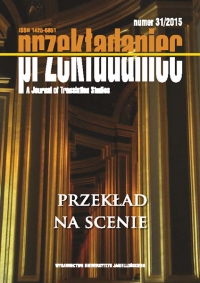Didaskalia w Orestei Ajschylosa jako projekt inscenizacji tłumacza (na przykładzie Ofiarnic)
Stage Directions in Aeschylus’s Oresteia as Translator’s Prospective Staging (on the Example of Aeschylus’s Choeforoe)
Author(s): Barbara BibikSubject(s): Translation Studies
Published by: Wydawnictwo Uniwersytetu Jagiellońskiego
Keywords: Aeschylus; Oresteia; The Libation Bearers; Węclewski
Summary/Abstract: Translators, as it is argued by translation scholars, often become the first directors of plays. This happens because taking into account the dramatic potential of the translated text results in the translator’s own projections about the possible staging that are inserted in the translated text. In ancient tragedies there were no written stage directions. But it does not mean that there were no stage instructions. Oliver Taplin, who sees the texts of ancient tragedies as a kind of theatre scripts, observes that the majority of information needed to perform any ancient tragedy is implicite included in the text itself. The fact that we do not have any written records of any performances that took place in 5th century BC makes it possible for the translator to imagine a prospective staging. Undoubtedly, the 5th century BC tragedies were the theatre productions influenced by the Athenian theatre of the day – its natural location, architecture, theatre equipment and stage design. So a translation that aims to be both literary and theatrically significant has to include the theatre dimension. Inserting stage directions into the translation is one of the means to do this (and we find them in almost all modern translations of ancient plays). In my paper I discuss three main Polish translations of Aeschylus’s Choeforoe (the second part of the only extant ancient trilogy titled Oresteia), taking into consideration the stage directions inserted by the translators. The versions by Zygmunt Węclewski (published in 1873), Jan Kasprowicz (in 1908) and Stefan Srebrny (in 1952) are examined in view of the question what kind of staging the translators suggested and why.
Journal: Przekładaniec.
- Issue Year: 2015
- Issue No: 31
- Page Range: 75-89
- Page Count: 15
- Language: Polish

